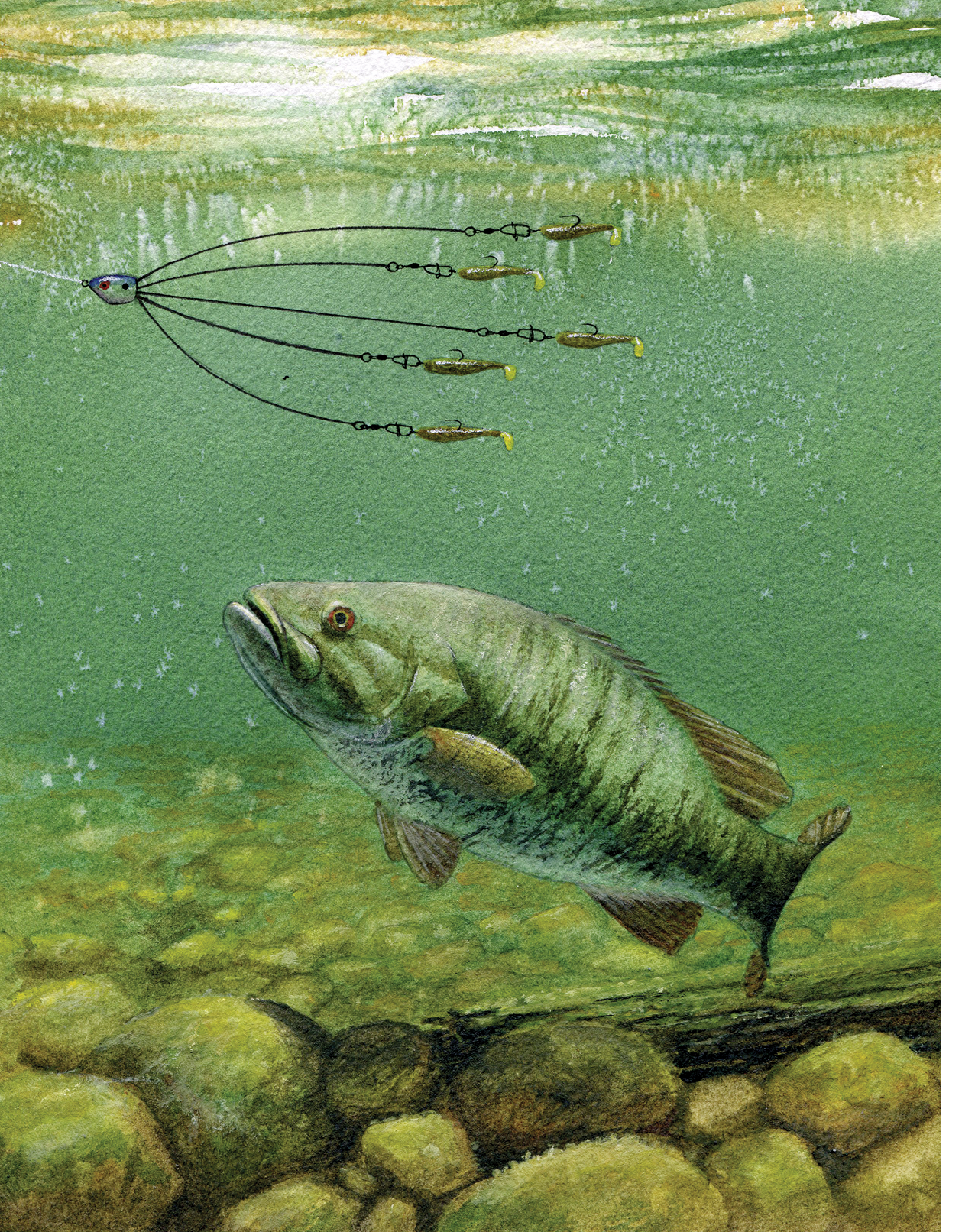
Umbrella rigs aren’t just for largemouth anymore. Here are the keys to uncuffing a multibait tactic that will not only help you locate brown bass, but fill the livewell with keepers in very short order.
We’ve heard about the gigantic catches of largemouth bass on Southern impoundments taken on umbrella rigs.
So, what about Northern waters?
Ben Nielsen says smallmouth not only love them, too, but some of the most incredible days he’s had, have come on the rig when other tactics weren’t working.
Nielsen is among a growing legion of Northern fishermen who have adapted the rig for catching big smallmouth from the Great Lakes, its connecting waters and some inland lakes.
“It’s unreal how fast you can load the boat with it,” says the Lowell, Mich., angler. “We’ve taken what we learned from the boys down South and adapted it to smallmouth fishing.”
For example, last fall, Nielsen was fishing a tournament on Elk and Torch lakes. He and his partner noticed that the few bass they caught on other tactics were spitting up baby walleye in the livewell.
“We picked up the rig, put on swimbaits that matched the young walleye in sizes and colors and absolutely hammered the snot out of ’em,” he describes.
You really don’t hear much about umbrella rig fishing during the summer months in the South, but Nielsen says it can work in the cooler waters around the Great Lakes at that time of year.
“It’s obviously better during the spring and fall, but yeah, you can make it work other times of the year,” he says. “If the bass are schooling and keying on baitfish — and you find the bait and bass — you bet it works!”
The Bassmasters TV co-host Mark Zona, an avid Michigan angler, is another who has become an umbrella rig disciple. It’s not as effective on lakes where bluegill are the primary forage, he says, but others that offer alewives, smelt or perch set up well for the umbrella rig.
“There’s no doubt you can have a ball fishing bottom baits like tubes, grubs or even spinnerbaits when the fish are feeding shallow,” Zona says. “But, with smallmouth, that only happens a small percentage of the time. The rest of the time they are roaming around the lake, eating baitfish.”
And that’s where the umbrella rig comes into play. By rigging with swimbaits that are match with the local forage, anglers can get on those schools and trigger them to bite.
How To Find Them
Smallmouth are nomadic; one day they may be on a weedbed or rockpile, only to be found several hundred yards out on a dropoff the next day.
As frustrating as that can be, the rig can help you find them.
For example, if the bass aren’t using the flats where he previously caught them, Nielsen gets on the trolling motor and starts working his way out toward deeper water.
“If [they’re] not on one structure, back off to the next one,” he says. “It might be a deeper weed clump or a gravel bar farther offshore. I use the rig as a search tool and just start making long casts as I work out deeper until I find them.”
When that doesn’t work, he monitors his electronics for schools of bait while idling over deep water.
“Once I find the bait, I start fishing around it and can usually reconnect with the fish,” he adds.
There are times, he says, when he uses the rig as a search tool, such as during a 2014 Bassmaster Northern Open on Lake St. Clair where he finished in eighth place. (Umbrella rigs are not allowed in this year’s Bassmaster Opens.)
“The rig clued me in on everything,” Nielsen insists. “I caught a few on it, but they were smaller fish. But once I found those, I realized the bigger bass were feeding on crawfish, so I switched [to] a drop shot rig and an Erie Darter on a jighead, and that produced my better fish.”
There are times when the smallmouth will just swat at the rig but not take the baits. For that reason, he keeps a follow-up bait ready — generally a drop shot rig — to throw in the area where the hit occurred.
“Before I make another cast with the rig, I throw my drop shot in there,” he says. “If I get the drop shot in the right spot, I’ll catch that fish 50 percent of the time.”
Nielsen has caught bass on the rig in water as shallow as 3 feet and as deep as 40. He says you can slow roll it near the bottom in deep water and catch bass or burn it over shallows.
“It’s like a lot of other lures you use,” he says. “You have to experiment with retrieves to find out how the fish want it. And it can change throughout the day.”
Zona added that the smallmouth typically linger near the bottom on sunny days but will suspend on cloudy days, so you must retrieve the rig accordingly.
In either case, both anglers say it’s imperative to “flare” the rig during the retrieve. In other words, if you’re winding it steadily, periodically spin the reel handle quickly to make the swimbaits jump erratically like a school of baitfish.
“I rarely get bit just winding the rig,” Zona adds. “The majority of the bites come when I spin the handle quickly. Then it becomes a matter of determining which cadence the fish want. Is it three slow rolls or more or less flares? Once you dial that in, it’s crazy how many bites you get.”
It’s not uncommon to get multiple smallmouth to hit the rig, and, as Nielsen says, when you get a 5-pounder and a 3-pounder on simultaneously, “It’s a rodeo!”
Zona has learned you can entice multiple bites by not setting the hook immediately when one fish bites it. It fires up the school.
“He’s already hooked himself, so just keep winding on the bait and there’s a good chance others in that school will want a piece of the action,” he says. “I’ve caught dozens of doubles and triples by doing that.”
The rig

Both Nielsen and Zona prefer the Strike King five-arm Titanium umbrella rig because the flexible Titanium pulses and flares so easily. However, if Nielsen thinks he needs a bigger spread, he will go to the seven-wire Sniper Frenzy rig.
Michigan anglers are limited to five baits, so he adds two dummies (swimbaits without hooks) into the mix.
“Oddly enough, there are days when having more baits on the rig catches more fish,” he explains. “This isn’t a rig you just put together and cast and catch fish. There are a lot of subtleties you have to pay attention to.”
Both anglers experiment with sizes and colors of baits, but always try to match the hatch. Zona prefers the 5-inch Strike King Swim-N-Shiner; Nielsen likes the Keitech 3.8 Fat Swing Impact swimbait but may add a larger 4.3 or 4.8 into the mix for variety.
“The beauty of the Keitech is that you can crawl it and it will still swim,” says Nielsen, who doesn’t have a lure sponsor. “It’s one of the few out there that has great action at all speeds.”
Another key is jighead weights and how you position the colors of the rig. Never throw an umbrella with jigheads of the same size; start light at the top, with heavier ones at the bottom to ensure the rig runs properly.
Nielsen places his dummy rigs on top with no weight or no more than 1/8 ounce, fills in the middle with 1/4-ounce jigs and keeps the 3/8-ounce versions at the bottom of the rig.
He will put accent colors, like ayu, at the top, with Tennessee shad or electric chicken near the bottom. He may even mix in an all-white or a sungill color that resembles perch or walleye.
“I think the fish get confused if all the baits are the same color,” he notes. “I’ve seen them swarm the rig and not bite, and I think it’s because they don’t know which one to take. If you use one of a different color, that’s usually the one that gets bit.”
Zona prefers gizzard shad as his dominant color but will use chartreuse marking dye to place dots on each side of one bait and color its tail.
“That’s my target bait and the one that gets bit most,” he explains.
The gear
Long rods are imperative for hurling this mob of baits, but there are other features to consider. First, the rod must be lightweight; the heavy hardware will wear you out during a day of fishing. Both Nielsen and Zona like the 7-7 G.Loomis NRX 916 Umbrella rod because of its light weight, soft tip and firm backbone.
Zona, who says you need a reel with a bigger spool for launching the rig, uses a Shimano Antares baitcaster, while Nielsen uses a Shimano Chronarch. Medium- to high-speed reels are preferred.
Although some anglers fish umbrella rigs on braid, both anglers say 20-pound fluorocarbon is best.
“It makes a huge difference,” Nielsen says. “It’s far less visible, plus it has a little stretch. Smallmouth may hit the rig three or four times before they eat it. On braid, you don’t get those follow-up strikes, and I think it’s because they feel the line resistance.”
Umbrella rig aficionados will tell you the key to fishing it is to not put it down.
“That’s hard to do when you think it’s not working,” Nielsen says. “But when you learn the power of this thing, it’s hard to put it down. It’s very addicting and certainly an exciting way to fish.”
Originally published Bassmaster Magazine 2016.






